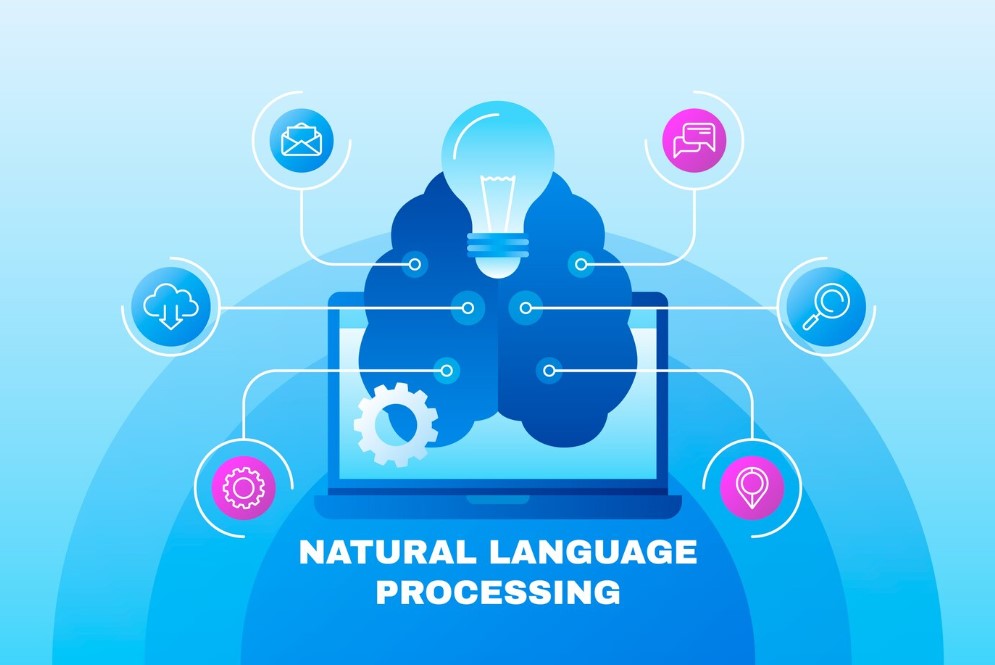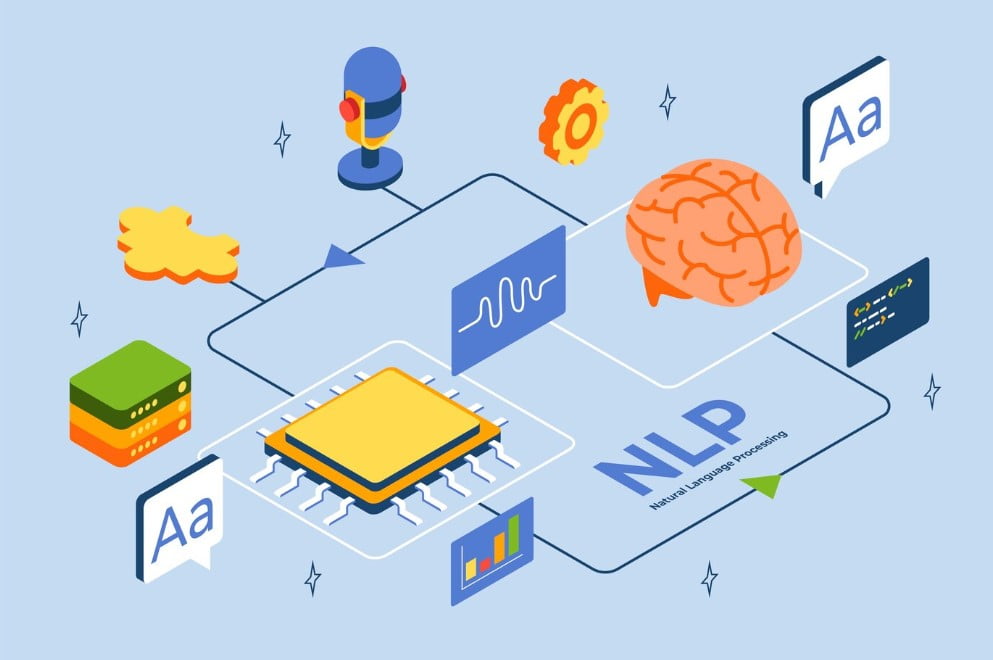Have you ever wondered how machines can understand human language? The answer lies in the world of natural language processing (NLP), a field that has transformed language understanding and revolutionized the way we interact with technology.
Using cutting-edge AI techniques, NLP enables machines to analyze, interpret, and respond to human language, opening up endless possibilities for communication and automation. In this article, we will explore the evolution of NLP, its key techniques, applications in business and industry, and future trends, as well as the ethical considerations that come with its use.
Get ready to unravel the fascinating world of natural language processing, where machines can understand your every word.
Table of Contents
Understanding Natural Language Process

As the ability to communicate has always been central to human experience, investigate the intricacies of natural language processing (NLP) in detail. With NLP, machines use AI techniques to analyze, interpret, and respond to human language. These include language processing algorithms, statistical machine learning techniques, and computational linguistics. These systems enable digital tools to work seamlessly with language in ways that were previously impossible. Computational linguistics, which is the study of how to build computational models of language and meaning, is essential to NLP. It leverages statistical machine learning and symbolic reasoning methods to extract meaning and context from unstructured text, enabling NLP to interact with human language much more effectively and coherently than ever before.
The Evolution of NLP

From its humble beginnings to today’s advanced machine learning algorithms, the evolution of Natural Language Processing (NLP) has revolutionized language understanding and text analysis. Early NLP methods were rule-based and focused on simple syntax and grammar rules. However, with the advent of machine learning, NLP has grown increasingly sophisticated.
One of the major breakthroughs in NLP was the introduction of statistical approaches, which relied on analyzing large amounts of data to identify patterns and relationships between words. These methods proved highly effective in language modeling and machine translation. Another milestone was the development of neural networks, which allowed for greater accuracy in speech recognition and image classification.
Today, NLP is used in a wide range of applications, from virtual assistants like Apple’s Siri and Amazon’s Alexa to advanced sentiment analysis tools used in marketing research. The ability of machines to understand and interact with human language has transformed the way we live and work, and there’s no doubt the evolution of NLP will continue to shape our world in the years ahead.
NLP in Everyday Life
Have you ever used Siri or Alexa to ask a question, or chatted with a customer service bot? If so, you’ve already experienced the power of natural language processing (NLP) in your daily life.
NLP has revolutionized the way we communicate with technology. By analyzing natural language and understanding context, NLP algorithms can accurately interpret our intentions and respond accordingly.
NLP is used in a wide range of applications, including:
- Virtual assistants like Siri and Alexa
- Chatbots for customer service
- Language translation tools
- Sentiment analysis for market research
With NLP, machines can understand us better than ever before, allowing for more streamlined communication and decision-making.
Key Techniques in NLP

As natural language process (NLP) continues to push boundaries in revolutionizing communication, understanding the key techniques becomes more critical for advancement. NLP uses various AI techniques to read, interpret, and understand human language.
One such key technique is semantic analysis, which looks at words’ context and meaning within a sentence. This technique helps machines understand a text’s tone, intention, and emotion, leading to more personalized and effective communications.
Information extraction is another essential technique that involves extracting relevant information from a text. This technique can identify specific details and entities within a document, resulting in more efficient analysis.
Other key techniques include part-of-speech tagging, named entity recognition, and sentiment analysis. These techniques help machines categorize words and understand the text’s overall meaning, making NLP more effective and efficient.
Challenges in NLP
Natural Language Processing (NLP) faces several challenges that restrict its effectiveness, including:
- Ambiguity and context: NLP struggles to deal with the complex nature of language, where the same word or phrase can have different meanings based on context. Machines may struggle to identify the intended meaning and provide an appropriate response.
- Language variations: Different languages have their own set of rules, nuances, and informal expressions that can vary from region to region. Machine learning algorithms need to be trained on datasets that capture these variations to achieve better accuracy.
- Cultural nuances: Cultural factors can also influence language use, such as idioms, sarcasm, and humor, which can be challenging for NLP systems to identify and interpret.
However, machine learning and computational linguistics are key to overcoming these obstacles. Through machine learning algorithms, systems can analyze vast amounts of training data and make accurate predictions based on patterns and rules. Furthermore, computational linguistics focuses on using linguistic theories and algorithms to develop NLP systems that can understand and interpret language more accurately.
NLP in Business and Industry
You might be surprised to learn just how much natural language processing (NLP) impacts the business world. From streamlining customer service to analyzing feedback, businesses are relying on NLP to automate data analysis and improve search engine results.
In the customer service sector, NLP-powered chatbots and virtual assistants enable customers to receive quick and efficient assistance. Large companies such as Amazon and Apple are using NLP to enhance their search engines, improving their accuracy and relevance.
| Industry | Applications of NLP |
|---|---|
| Retail | Improving search engines, chatbots, sentiment analysis |
| Finance | Automating data analysis, fraud detection, risk analysis |
| Healthcare | Medical language processing, patient data analysis |
In finance, NLP is being used for automated data analysis, fraud detection, and risk analysis, while in healthcare, it’s being applied to medical language processing and patient data analysis. NLP allows businesses to derive insights from large volumes of data, enabling them to make better decisions and offer improved customer experiences.
Case Study: IBM Watson
One example of a company utilizing NLP is IBM Watson, which has developed a robust suite of AI-powered tools based on NLP. Watson’s enterprise-level NLP tools enable businesses to analyze customer feedback, gain insights from social media, and identify trends in consumer behavior. The ability to effectively analyze and interpret language data is a game-changer for businesses looking to stay ahead of the competition.
As technology continues to evolve, the integration of NLP across industries will become more prevalent. Those businesses that embrace NLP will likely benefit from increased efficiency and greater customer satisfaction.
Future Trends in NLP
As the world of natural language processing (NLP) continues to evolve, exciting possibilities are on the horizon. The advancements in AI techniques and machine learning algorithms will shape the future of language understanding. Emerging trends such as deep learning, neural networks, and advanced machine learning algorithms will accelerate the transformation of NLP.
Deep learning will enable machines to recognize patterns and make decisions that are more accurate than ever before. Neural networks will enhance language understanding and improve the accuracy of language models. Advanced machine learning algorithms will enable machines to learn from data and perform complex tasks such as language translation and sentiment analysis with greater efficiency and accuracy.
Emerging Trends in NLP
| Trend | Description |
|---|---|
| Deep Learning | Using neural networks to recognize patterns and make decisions |
| Neural Networks | Enhancing language understanding and improving language models |
| Advanced Machine Learning | Enabling machines to learn from data and perform complex tasks efficiently |
The future of NLP is bright, and the possibilities are endless. With the rapid advancements in AI techniques and machine learning, the way we communicate and interact with technology will continue to evolve, resulting in a more immersive and personalized experience.
Ethical Considerations in NLP
As natural language processing (NLP) becomes increasingly prevalent in our daily lives, there are ethical considerations to be made. Privacy concerns arise from the vast amounts of data gathered and analyzed by AI techniques. Bias in language models, such as racial or gender bias, must be addressed to ensure fairness. The responsible use of AI techniques is also critical, as improper use of NLP can lead to unintended consequences.
Therefore, the importance of ethical frameworks and guidelines in shaping the future of NLP cannot be overstated. As developers continue to push the boundaries of language understanding, it is essential to consider the potential impact on society and individuals. NLP must be developed responsibly with ethical considerations at the forefront.
Conclusion
Congratulations, you have gained a comprehensive understanding of natural language processing (NLP) and its impact on language understanding. By exploring the evolution, key techniques, challenges, and ethical considerations of NLP, you have gained insights into its wide-ranging applications in our daily lives and various sectors.
The potential of NLP to revolutionize communication through AI techniques and semantic analysis is immense. As you reflect on the advancements made in NLP and its future trends, you can envision how it will transform our interactions with technology and drive innovations in language understanding.
With NLP at the forefront of technological advancements, it is imperative to consider the ethical implications of its use. Privacy concerns, bias in language models, and responsible use of AI techniques must be addressed through ethical frameworks and guidelines.
As you conclude your journey into the world of NLP, you cannot deny its significant impact on language understanding and revolutionizing communication. With an ever-increasing demand for smarter technology, NLP is sure to play a vital role in shaping the future.

